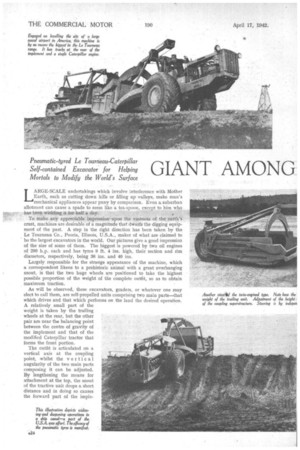GIANT AMONG =EARTH MOVERS
Page 26

Page 27

If you've noticed an error in this article please click here to report it so we can fix it.
LARGE-SCALE undertakings which involve interference with Mother Earth, such as cutting down hills or filling up valleys, make man's mechanical appliances appear puny by comparison. Even a suburban allotment can cause a spade to seem like a tea-spoon, except to him who
has been wielding it for half a day. .
To make any appreciable impression. upon the vastness of the earth's crust, machines are desirable of a magnitude that dwarfs the digging equipment of the past. A step in the right direction has been taken by the Le Tourneau Co., Peoria, Illinois, U.S.A., maker of what are claimed to be the largest excavators in the world. Our pictures give a good impression of the size of some of them. The biggest is powered by two oil engines of 200 h.p. each and has tyres 9 ft. 4 ins, high, their section and rim diameters, respectively, being 36 ins. and 40 ins.
Largely responsible for the strange appearance of the machine, which a correspondent likens to a prehistoric animal with a great overhanging snout, is that the two huge wheels are positioned to take the highest possible proportion of the weight of the complete outfit, so as to obtain maximum traction.
As will be observed, these excavators, graders, or whatever one may elect to call them, are self-propelled units comprising two main parts—that which drives and that which performs on the land the desired operation. A relatively small part of the weight is taken by the trailing wheels at the rear, but the other pair are near th* balancing point between the centre of gravity of the implement and that of the modified Caterpillar tractor that forms the front portion.
The outfit is articulated on a vertical axis at the coupling point, whilst the vertical angularity of the two main parts composing it can be adjusted. By lengthening the means for attachment at the top, the snout of the tractive unit drops a short distance and in doing so causes the forward part of the imple ment to be raised, the transverse hinge being at about the mid point. Obviously this machine is a development of the combination of Caterpillar track-laying tractor and Le Tonneau grader that has become•
quite well known in this country in the field of public works, and this fact at once prompts the question. Why are pneumatic tyres now employed?
There are several reasons; some of which seem to be controversial. No doubt, however, results have been the deciding factor.
Greater speed is possible with the pneumatic equipment, so that more trips can be accomplished per hour and the job performed with greater expedition. It is capable of 25 m.p.h. This is certainly an important reason.
Smoother running and reduced tractive resistance ensue from the use of low-pressure tyres, which mean that the mechanism functions under better conditions and is able to operate at lower stress and/or more effectively. Consequences in this case must include lower running costs, less maintenance and retarded depreciation.
A further claim put forward is that apparatus on pneumatic tyres can be used under worse weather conditions than can that running on tracks. We suggest that this is one of the controversial points.
Control of the outfit is said to be quite easy. Steering is effected by driving through only one wheel, the other being declutched and braked through interconnected • gear. Excellent manceuvrability results. Another feature in the same connection and particularly valuable from the operational point of view is that the tyres are set within the width of the cutting blade.
Furthermore, the blade is adjustable in respect of angle to the extent of 30 degrees either way. Thus it is suitable, our correspondent writes, for sidecasting or head-on 'dozing. The machine is designed for use with a variety of equipment.




















































